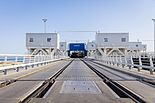
The transport in Azerbaijan involves air traffic, waterways and railroads. All transportation services in Azerbaijan except for oil and gas pipelines are regulated by the Ministry of Transportation of Azerbaijan Republic.

Jurong Port Pte Ltd is a port operator headquartered in Singapore. Jurong Port, which operates the only multi-purpose port in Singapore, handles bulk, break-bulk and containerised cargo. It handled over 40,000 vessel-calls annually in 2019.

CMA CGM is a French shipping and logistics company founded in 1978 by Jacques Saadé.
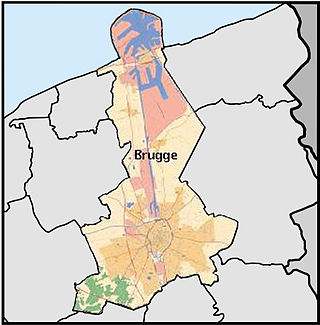
The Port of Zeebrugge is a large container, bulk cargo, new vehicles and passenger ferry terminal port on the North Sea. The port is located in the municipality of Bruges, West Flanders in the Flemish Region of Belgium, handling over 50 million tonnes of cargo annually.
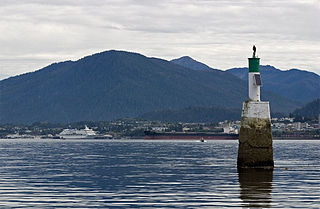
The Port of Prince Rupert is a seaport managed by the Prince Rupert Port Authority that occupies 667,731 hectares of land and water along 20 kilometres of waterfront. The port is located in Prince Rupert Harbour in the North Coast Regional District of British Columbia.

The Port of Savannah is a major U.S. seaport located at Savannah, Georgia. As of 2021, the port was the third busiest seaport in the United States. Its facilities for oceangoing vessels line both sides of the Savannah River and are approximately 18 miles (29 km) from the Atlantic Ocean. Operated by the Georgia Ports Authority (GPA), the Port of Savannah competes primarily with the Port of Charleston in Charleston, South Carolina to the northeast, and the Port of Jacksonville in Jacksonville, Florida to the south. The GPA operates one other Atlantic seaport in Georgia, the Port of Brunswick. The state also manages three interior ports linked to the Gulf of Mexico: Port Bainbridge, Port Columbus, and a facility at Cordele, Georgia linked by rail to the Port of Savannah. In the 1950s, the Port of Savannah was the only facility to see an increase in trade while the country experienced a decline in trade of 5%. It was chaired and led by engineer Dr. Blake Van Leer.

Jawaharlal Nehru Port, also known as JNPT and Nhava Sheva Port, is the second largest container port in India after Mundra Port. Operated by the Jawaharlal Nehru Port Trust Authority (JNPTA), it is located on the eastern shores of Arabian Sea in Navi Mumbai, Raigad district, Maharashtra. This port can be accessed via Thane Creek, a nodal city of Navi Mumbai. It is the main port of the Mumbai Metropolitan Region after Mumbai Port, also of Maharashtra and Western India. Its common name derives from the names of Nhava and Sheva villages that are situated here. It is also the terminal of the Western Dedicated Freight Corridor.
International Container Terminal Services, Inc. (ICTSI) is a global port management company headquartered in Manila, Philippines. Established in 1916, ICTSI is the Philippines' largest multinational and transnational company, having established operations in both developed and emerging market economies in Asia Pacific, the Americas, and Europe, the Middle East and Africa. The company is ranked the eighth largest container terminal operator, according to TEU equity volume.
Olya is a rural locality in Limansky District of Astrakhan Oblast, Russia, on the shore of one of the largest branches of the Volga River, Bakhtemir, near the Caspian Sea about 120 kilometers (75 mi) southwest of Astrakhan. It serves as a port on the Caspian Sea. In 2010 the settlement recorded 1372 farmsteads and 3752 residents. The port's cargo turnover was approximately 2.5 million tons as of 2006.

The Port of Haydarpaşa, also known as the Port of Haidar Pasha or the Port of Istanbul, is a general cargo seaport, ro-ro and container terminal, situated in Haydarpaşa, Istanbul, Turkey at the southern entrance to the Bosphorus, near Haydarpaşa Station. It is operated by the Turkish State Railways (TCDD) and serves a hinterland which includes the country's most industrialised areas.

The Baku–Tbilisi–Kars (BTK), or Baku–Tbilisi–Akhalkalaki–Kars railway (BTAK), is a railway connecting Azerbaijan, Georgia and Turkey, which became operational on 30 October 2017 following several years of delays. The project was originally due to be completed by 2010, but was delayed to 2013, 2015, 2016, and, following a fifth trilateral meeting in February 2016, foreign ministers of the three countries announced that the railway would finally be completed in 2017.
The Port of Constanța is located in Constanța, Romania, on the western coast of the Black Sea, 179 nautical miles (332 km) from the Bosphorus Strait and 85 nmi (157 km) from the Sulina Branch, through which the Danube river flows into the sea. It covers 3,926 ha, of which 1,313 ha is land and the rest, 2,613 ha is water. The two breakwaters located northwards and southwards shelter the port, creating the safest conditions for port activities. The present length of the north breakwater is 8,344 m (5.185 mi) and the south breakwater is 5,560 m (3.45 mi). The Port of Constanța is the largest on the Black Sea and the 17th largest in Europe.
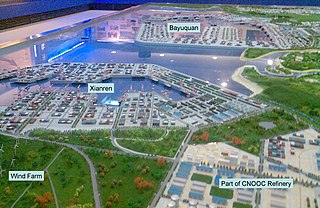
The Port of Yingkou is an international seaport in Yingkou, Liaoning, People's Republic of China. It is the second-largest port in northeast China and the tenth-largest nationwide. It includes two separate dockland areas, the Yingkou old port at the mouth of the Daliao River, and the Bayuquan port located directly on Liaodong Bay on the Bohai Sea.
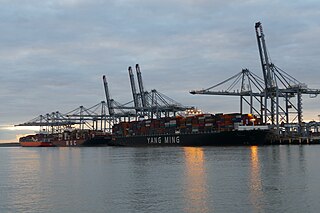
DP World London Gateway is a port within the wider Port of London, on the north bank of the River Thames in Thurrock, Essex. Opened in November 2013, the site is a fully integrated logistics facility, consisting of a semi-automated deep-sea container terminal which is on the same site as a land bank for the development of warehousing, distribution facilities, and ancillary logistics services.
Manzanillo International Terminal is located east of the Atlantic opening of the Panama Canal on Manzanillo Bay, Colón Province, Panama.

The Port of Cork is the main port serving the south of Ireland, County Cork and Cork City. It is one of the three "Ports of National Significance " as designated by National Ports Policy.

Azerbaijan Railways is the national state-owned rail transport operator in the Republic of Azerbaijan. The 2,918 km (1,813 mi), 1,520 mm gauge network is electrified at 3 kV (3,000 V) DC. The headquarters of the Azerbaijan Railways is in the capital Baku.
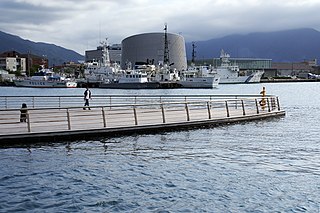
The Tsuruga Port is now one of the three main ports on the Sea of Japan.

The Türkmenbaşy International Seaport is the main passenger harbour and cargo port in Türkmenbaşy, Turkmenistan.
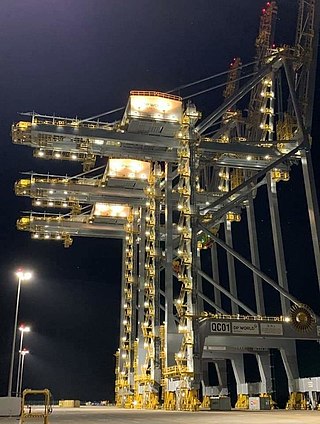
The DP World Berbera New Port, also known as DP World Berbera, is the new port of the DP World in the city of Berbera and its only branch in Republic of Somaliland.




